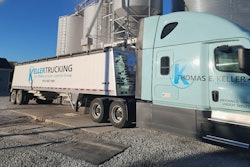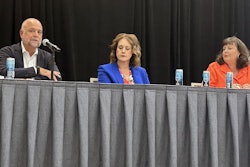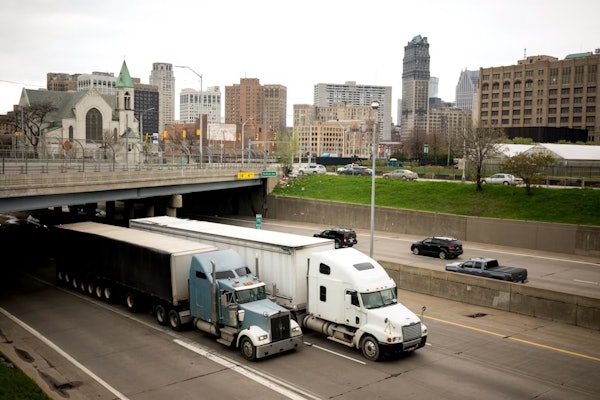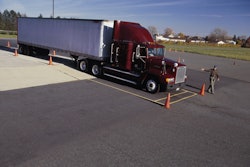The signs of a freight recovery that appeared early this year are gone, replaced by a tough market where recovery will have to come from a supply-side correction, American Trucking Associations' Chief Economist Bob Costello said Monday at ATA's 2025 Management Conference & Exhibition in San Diego.
Costello delivered a blunt and sobering economic warning: new tariffs, persistent stagflation, and a slowing labor market have created "absolutely unsustainable" conditions for many carriers, and the only way out, at least near-term, is to erase capacity from the highway.
"It's not easy to talk about because it's people's livelihoods, but it's a necessary evil," Costello said, noting that freight demand is unlikely to improve anytime soon. "This has got to be a supply-driven change in the market."
Macro-economic headwinds
The current 18% effective tariff rate, nearly six times higher than it was during the first Trump administration, is a level not seen since the 1930s. Costello warned that the industry is only in the "bottom of the second or top of the third inning" of feeling the impact. "Any benefits of putting tariffs on foreign goods... are years in the future, but the cost hits much quicker," he said.
Tariffs will impact inflation and could go up to 4% year-over-year, Costello said, before slowing. But prices will rise and stay high unless the tariffs are reduced or eliminated, he added. Overall, prices are up more than 26% since 2020.
The three primary sources of truck freight—construction, manufacturing, and retail—all have a weak near-term outlook.
- Construction: The housing market is forecast to see significant declines in 2025. The base case forecast calls for single-family housing starts to fall by 7.2% (with a worst-case of -9.8%). Multi-family construction spending is projected to drop 6.6% (worst case -8.5%), and real non-residential construction spending is forecast to fall 5.5% (worst case -6.5%).
"One area that had been really good was non-residential construction. Big data centers and even some factories. While there are pockets of strength... the new swear word is uncertainty," Costello said. "Uncertainty means less investment. And as you do that, you're going to reduce the non-residential (construction), which is everything but housing."
- Manufacturing: Tariffs are hurting factory output, and forecasts for 2025 are weak, projecting just 1% growth in the base case and just 0.6% in the worst case. The 2026 forecast is even weaker, projecting a -0.1% decline in the base case. Manufacturers have cut 42,000 jobs over the last four months.
"Of course we all want free and fair trade, but [tariffs are] a very blunt tool to try to achieve that free and fair trade," Costello said. "And there's going be casualties and it's going to hurt, especially around U.S. manufacturing."
- Retail: Consumer spending is being propped up by the top 20% of earners, who now account for roughly two-thirds of all spending, and job growth is slowing. After averaging 400,000 new jobs per month from 2021-2022, recent figures have slowed to as low as 27,000 per month
Freight demand remains depressed
- Truckload: Contract loads were down 2.1% year-over-year in the third quarter of 2025. While spot market postings are up 30.2% year-over-year from their 2024 low, they are well below the peaks seen in 2021 and 2022.
- LTL: LTL tonnage was down 1.6% year-over-year in Q3 2025, though shipments saw a slight 2.5% increase. "LTL shipments are starting to improve. Tonnage is not," Costello said. "It tells us that average weight per shipment is not getting any better."
- National metrics: U.S. Bank national freight metrics show shipments were down 10.7% year-over-year in Q3 2025, while spending was down 1.7%. Regionally, the Southwest has been hit hardest, with shipments plummeting 32.8% year-over-year.
A bright spot, Costello said, is that private fleet growth has finally ended and is reversing.
"Private fleets grew just after the pandemic. So, as we were in the pandemic craziness and freight was going crazy, there were a lot of frustrated shippers," he said. "Some of them had fleets and they decided to grow that privately. It was a knee-jerk reaction that I think they sort of second-guessed or regretted. They are contracting again, and I think that will put more freight into the for-hire market."
Higher costs vs. lower rates changing the market
While freight demand is weak, pricing has seen a slight improvement, Costello said. In Q3 2025, contract truckload revenue per mile (minus fuel) was up 1.6% year-over-year, and LTL revenue per ton was up 1.8%.
However, this uptick comes after years of cost increases. Operational costs for fleets (excluding fuel) climbed 9.7% in both 2021 and 2022, 6.6% in 2023, and 3.6% in 2024. By last year, a 26% gap had opened up between the rise in operational costs and truckload revenue per mile.
This sustained cost pressure is forcing a supply correction. Since December 2022, the number of authorized interstate property carriers has fallen by 10.6%, representing an exit of more than 39,000 carriers. The number of non-local truckload and LTL employee drivers has also fallen 49,800 (6.9%) from its high point in late 2022.
Costello noted that while supply had been slow to leave the market, partly because lenders didn't want the used over-leveraged equipment, that is changing and carrier exits could soon accelerate as more banks call more notes.
![Mce25 Costello[47] 37](https://img.ccjdigital.com/mindful/rr/workspaces/default/uploads/2025/10/mce25-costello47-37.61GwQ80BxO.jpg?auto=format%2Ccompress&fit=max&q=70&w=400)
Unlike past down cycles, Costello said it is easier for carriers to now get freight, even if they lose money on the load. But many small fleets and independent contractors are now on the brink of failure, having wiped out financial cushions after bankrolling their operations with negative margins.
Fleets have been working to reduce costs, but some efforts, like deferred maintenance, will cause significant long-term problems, Costello noted, driving even more carriers out of business.
Costello said he believes further supply reduction would come via enforcement of English Language Proficiency (ELP) regulations (violations have spiked this year with 5,254 out-of-service violations recorded to date), and pointed to "illegal capacity" from fleets that illegally use Mexican B-1 drivers for domestic loads, adding that ATA is working with the Department of Homeland Security to "crack down on this illegal activity."















